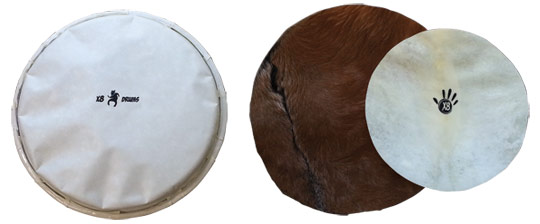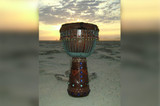Drumhead Myths Debunked
 |
There seems to be a myth that's been perpetuated within the drumming industry that synthetic drum heads are somehow superior to natural heads, especially when it comes to hand drums. This article will clear up some of those misunderstandings and clarify some of the differences between synthetic drum heads and natural heads.
 |
| Synthetic and Goatskin Drum Heads |
One of the main points that the manufacturers of synthetic drum heads use to sell their instruments, is that the head is not affected by temperature and/or humidity changes. Although natural heads do tend to get tighter as the weather gets drier and hotter, and looser as temperatures drop or humidity rises, this does not pose a problem unless the player either does not know how to tune his or her drum, or if slight fluctuations in pitch are unacceptable to the player. If keeping one's drum at a high pitch is important, any drop in pitch due to humidity or temperature can be quickly remedied by simply tuning up the drum. The tuning process for most hand drums takes only a minute or two at the most and is a common aspect of drum ownership. Imagine how absurd it would seem if a violinist or guitarist did not know how to tune his or her instrument! The same is true for any drummer.
Myth #1: Synthetic heads stay in tune better than natural heads.
Fact: Learning how to tune your drum is part of drum ownership and only takes a minute.
Another selling point that the manufacturers of synthetic drum heads like to use often, is that synthetic heads are durable, which they are. Natural skin heads are also durable when treated properly. Like the tuning issue, durability is not simply a property of the head itself, but can be seen as a dynamic feature of drum care. If someone does not know how to care for his or her drum, or does not care about the condition of his or her drum, then giving that person a drum with a natural skin might end up in that skin breaking sooner than a synthetic skin. On the other hand, if the user is sensitive to environmental changes and takes the time to care for his drumhead properly, it should last a long time.
Myth #2: Synthetic heads are more durable than natural heads.
Fact: If you learn how to take care of your drum, any head will last until it's time to replace it.
Something that is often not acknowledged within mainstream retail drum sales, is that all drums will eventually need to have their heads replaced. This holds true for both synthetic and natural skin heads. Given that, with a little bit of knowledge and attention to the care of a natural skinhead, that skin will last just as long as a synthetic head in terms of its sound quality lifespan. So the real question becomes, Which sound and feel do you prefer, as a musician? Remember that when you buy a drum, what you're really paying for is the shell, since you're likely to replace the head every year or two as the sound becomes dull and the head itself becomes more vulnerable to breaking. Every instrument, whether it's an ukulele, a saxophone, a cello or a snare drum, needs to be refreshed with new strings, a reed, a bow, or a head.
Myth #3: Synthetic heads don't need to be replaced.
Fact: To sound great, all heads need to be replaced sooner or later.
Before you assume that synthetic heads are "better" than the natural heads, consider this: Synthetic heads tend to be a little harder, dryer, and produce more overtones (or ringing) than do natural heads. Virtually all professional percussion groups that play traditional music use natural skin heads on their instruments. Why, with all the time and effort that goes into maintaining a natural skinhead, would these busy players choose to use natural heads? Why not take the low maintenance route and use a synthetic drumhead? For me the answer can be summed up in one word: Sound. While there are some synthetic heads that do sound quite good, to me, there's nothing like a natural head to bring out the warmth, body, and full musical potential of a hand drum. I also like the feel of a natural head - and when you're playing with your hands, feel is important.
When is it most appropriate to use synthetic heads? Probably under any circumstance where there might be extreme weather conditions or changes, or where there are many inexperienced drummers using the instruments, such as a large corporate, community, or school drum circle, for example.
Making an educated choice requires gathering quality information and resources, talking to professionals in the business, finding out what the top players are using, and not only reading ads in magazines or getting all your information from one company or the people who work for that company. Both synthetic and natural heads are useful in different ways and under different conditions. The take away here is that one is not necessarily better than the other. They are two different products with different qualities. - The choice is yours.
Recent Posts
-
What is the Best Size Djembe for Beginners?
If you're new to the world of percussion and interested in learning the djembe, you're in for a t …16th Jul 2024 -
The Benefits of Becoming a Drumming Teacher: Transforming Passion into Profession
Why become a drumming teacher? Becoming a drumming teacher is an excellent way to share your pas …22nd May 2024 -
What Makes the Djembe Drum a Spiritual Instrument in African Music?
Origin and history of the Djembe drum The Djembe drum originates from West Africa and holds sign …16th May 2024



